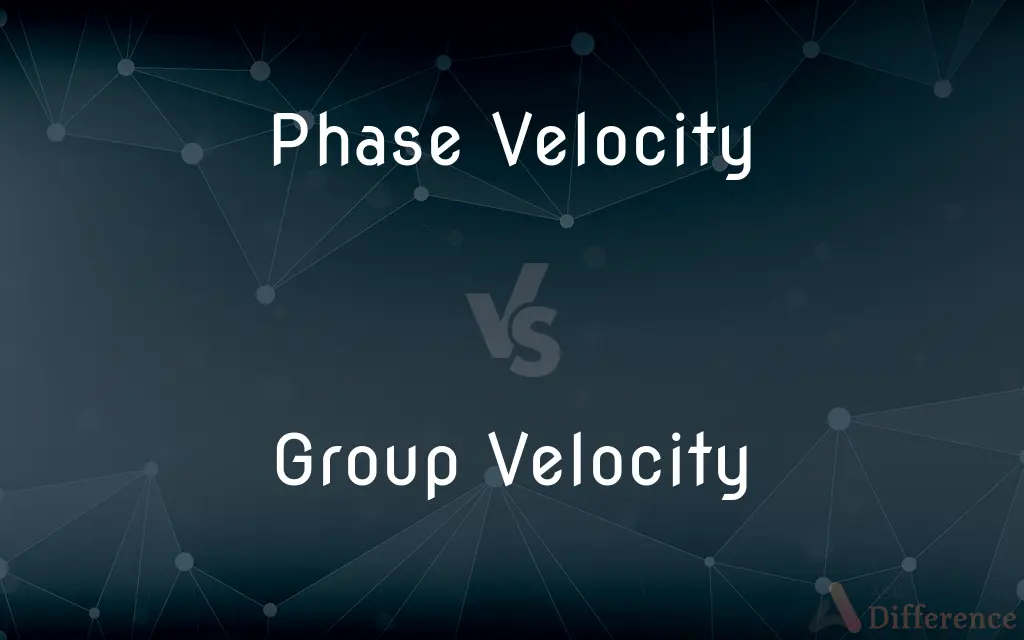Phase Velocity vs. Group Velocity — What's the Difference?
By Tayyaba Rehman — Published on October 25, 2023
Phase Velocity pertains to the speed of a wave's phase; Group Velocity concerns the speed of a wave packet or group of waves. Both describe different wave propagation characteristics.

Difference Between Phase Velocity and Group Velocity
Table of Contents
ADVERTISEMENT
Key Differences
Phase Velocity is a term used in wave mechanics to describe the speed at which a particular phase of a wave travels through a medium. This velocity depends on the wave's frequency and the medium's properties. In contrast, Group Velocity is the speed at which an overall shape of a wave's amplitudes, known as a wave packet, moves. It's often the velocity at which energy or information is transmitted.
In many contexts, especially when dealing with a single frequency wave, Phase Velocity can give crucial information about how quickly individual peaks and troughs of a wave are moving. However, Group Velocity becomes particularly significant when you have a collection of waves, or a wave packet. This is because while individual peaks may move at the phase velocity, the overall envelope of the wave packet moves at the group velocity.
There are specific scenarios, especially in dispersive mediums, where Phase Velocity and Group Velocity differ significantly. A dispersive medium is one where the phase velocity varies with frequency. In such cases, the Phase Velocity might be faster or slower than the Group Velocity, leading to the spreading out of wave packets.
To understand the real-world implications, consider communication systems. In these systems, the message is typically encoded as a wave packet. While the Phase Velocity will tell you how quickly an individual cycle of the wave is moving, it's the Group Velocity that indicates how fast your message is being transmitted.
In essence, both Phase Velocity and Group Velocity provide different insights into wave propagation. They are fundamental concepts in the fields of optics, acoustics, and quantum mechanics, among others.
ADVERTISEMENT
Comparison Chart
Definition
Speed of a wave's phase
Speed of a wave packet or group
Dependency
Depends on wave's frequency and medium's properties
Depends on how wave speed changes with frequency
Relevance in Dispersive Medium
Can differ significantly from group velocity
Represents speed of energy or information transmission
Physical Significance
Indicates how fast individual wave peaks move
Indicates how fast the overall shape or envelope of waves moves
Importance in Communication
Less relevant for understanding speed of information transmission
Crucial for understanding speed of information transmission
Compare with Definitions
Phase Velocity
Speed at which a wave's phase propagates.
In some mediums, the phase velocity can exceed the speed of light, but no information is transmitted at that speed.
Group Velocity
Speed at which a wave packet's shape propagates.
In communications, the group velocity is vital as it dictates how fast a message travels.
Phase Velocity
Relates to individual wave peaks and troughs.
Observing ripples in a pond, the phase velocity tells us how fast each ripple travels.
Group Velocity
Often the speed at which energy or information moves.
In optical fibers, the group velocity can impact data transmission rates.
Phase Velocity
Determined by wave frequency and medium properties.
In a vacuum, the phase velocity of electromagnetic waves is the speed of light.
Group Velocity
Concerns the overall envelope of a collection of waves.
If you observe a pulse on a string, the group velocity describes how fast that pulse travels.
Phase Velocity
Can differ from group velocity in dispersive media.
In fiber optics, the phase velocity of certain frequencies might vary due to the medium's dispersion.
Group Velocity
Can differ from phase velocity, especially in dispersive media.
In certain conditions, negative group velocity can occur, leading to wave packets that appear to move backward.
Common Curiosities
What does Phase Velocity describe?
Phase Velocity describes the speed at which a specific phase of a wave travels.
Can Phase Velocity ever exceed the speed of light?
Yes, in some mediums, phase velocity can surpass the speed of light, but it doesn't transmit information at that speed.
Why is Group Velocity important in communications?
Because it indicates how fast a message or signal, often represented as a wave packet, is transmitted.
Can Group Velocity and Phase Velocity be the same?
Yes, in non-dispersive mediums, they can be equal.
How is Group Velocity different from Phase Velocity?
Group Velocity relates to the speed of a wave packet or group of waves, often representing the speed of energy or information.
What's the significance of Group Velocity in quantum mechanics?
It's relevant in understanding the propagation of wave packets in quantum systems.
What's a dispersive medium?
It's a medium where the phase velocity varies with frequency.
What factors influence Phase Velocity?
Wave frequency and properties of the medium it travels through.
Do all waves have a Group Velocity and Phase Velocity?
Yes, every wave can be characterized by both, though their significance varies based on the context.
Does the speed of a wave packet always represent its Group Velocity?
Typically yes, as the group velocity describes the speed of the overall shape or envelope of waves.
What happens when Group Velocity is zero?
It implies a complete halt of the wave packet's movement, potentially due to interference or other effects.
Can Group Velocity be negative?
In specific conditions, yes, leading to wave packets that seem to move backward.
In what scenario is Phase Velocity most relevant?
When dealing with a single-frequency wave, especially to understand how fast individual peaks/troughs move.
Can energy be transported at the Phase Velocity?
Not necessarily. While individual wave peaks move at the phase velocity, the actual energy or information typically travels at the group velocity.
Can the Group and Phase Velocities diverge significantly?
Yes, especially in dispersive media where their values can differ notably.
Share Your Discovery

Previous Comparison
Internal Recruitment vs. External Recruitment
Next Comparison
Pity vs. EmpathyAuthor Spotlight
Written by
Tayyaba RehmanTayyaba Rehman is a distinguished writer, currently serving as a primary contributor to askdifference.com. As a researcher in semantics and etymology, Tayyaba's passion for the complexity of languages and their distinctions has found a perfect home on the platform. Tayyaba delves into the intricacies of language, distinguishing between commonly confused words and phrases, thereby providing clarity for readers worldwide.











































